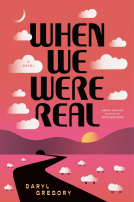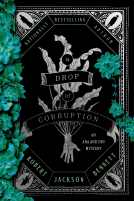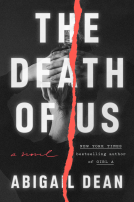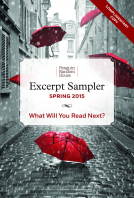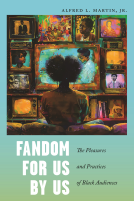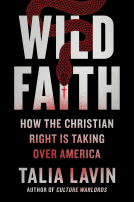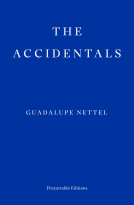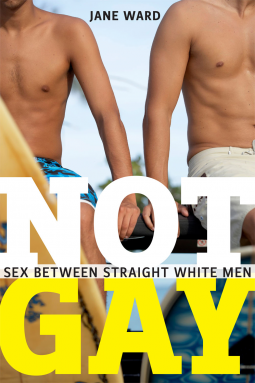
Not Gay
Sex between Straight White Men
by Jane Ward
This title was previously available on NetGalley and is now archived.
Send NetGalley books directly to your Kindle or Kindle app
1
To read on a Kindle or Kindle app, please add kindle@netgalley.com as an approved email address to receive files in your Amazon account. Click here for step-by-step instructions.
2
Also find your Kindle email address within your Amazon account, and enter it here.
Pub Date Jul 31 2015 | Archive Date Oct 19 2015
Description
A different look at heterosexuality in the twenty-first century
A straight white girl can kiss a girl, like it, and still call herself straight—her boyfriend may even encourage her. But can straight white guys experience the same easy sexual fluidity, or would kissing a guy just mean that they are really gay? Not Gay thrusts deep into a world where straight guy-on-guy action is not a myth but a reality: there’s fraternity and military hazing rituals, where new recruits are made to grab each other’s penises and stick fingers up their fellow members’ anuses; online personal ads, where straight men seek other straight men to masturbate with; and, last but not least, the long and clandestine history of straight men frequenting public restrooms for sexual encounters with other men. For Jane Ward, these sexual practices reveal a unique social space where straight white men can—and do—have sex with other straight white men; in fact, she argues, to do so reaffirms rather than challenges their gender and racial identity.
Ward illustrates that sex between straight white men allows them to leverage whiteness and masculinity to authenticate their heterosexuality in the context of sex with men. By understanding their same-sex sexual practice as meaningless, accidental, or even necessary, straight white men can perform homosexual contact in heterosexual ways. These sex acts are not slippages into a queer way of being or expressions of a desired but unarticulated gay identity. Instead, Ward argues, they reveal the fluidity and complexity that characterizes all human sexual desire. In the end, Ward’s analysis offers a new way to think about heterosexuality—not as the opposite or absence of homosexuality, but as its own unique mode of engaging in homosexual sex, a mode characterized by pretense, dis-identification and racial and heterosexual privilege. Daring, insightful, and brimming with wit, Not Gay is a fascinating new take on the complexities of heterosexuality in the modern era.
Advance Praise
“Clear-eyed and unsqueamish, Not Gay defiantly insists that sex between contemporary American straight white men is in fact meaningful sex that can't—and shouldn't—just be hand-waved away. Jane Ward provides a timely and convincing corrective."--Hanne Blank, author of Virgin: The Untouched History
“Not Gay is nothing less than a breath of fresh air. This book is certain to change the way that we think about heterosexuality’s relations with the homoerotic.”--Roderick Ferguson, author of Aberrations in Black: Toward a Queer of Color Critique
Marketing Plan
No Marketing Info Available
No Marketing Info Available
Available Editions
| EDITION | Other Format |
| ISBN | 9781479825172 |
| PRICE | $34.00 (USD) |
Links
Average rating from 49 members
Featured Reviews
 Educator 194902
Educator 194902
I appreciated this book for helping address some of the asymmetries with respect the men and women and sexual orientation. I was willing to follow the author to hear how she was linking straight, white men's sexuality to homosocial and homosexual sex as a means of shoring up straight, white men's heterosexuality. Well into the book her argument became clearer mainly by contrasting social discourses on straight women's foray into sex and/or relationships with straight white men's same-sex experiences, comparing how men of color's sexuality and sexual orientation is not allowed the same flexibility as white men's, and by analyzing three situations in which straight white men have been able to have sexual experiences with other men in a way that eschews the oppression associated with being a gay man and in a way that affirms their heterosexuality. Also, somehow I missed the term "heteroflexible" as a social phenomenon, so this book introduced me to that.
The author brings in her own experiences and recognizing how her identity and experiences shapes both the questions she has and the assumptions she holds. Toward the end of the book she discusses a distinction between gay and queer in terms of what those terms means or could mean in terms of possibility. The distinction seems important. I wish that had been covered earlier in the book.
If you are searching for a book with greater depth of analysis on people of color or comparing the social discourse of specific racial and ethnic minority groups with respect to sexual orientation, you will not find that in this book. Also, this book focuses on cisgender experience, so it is unclear how trans* identity may intersect with rigidity or flexibility of the sexuality orientation with which they identify or the intersection with race or gender.
 Jeff L, Reviewer
Jeff L, Reviewer
This is a fascinating, thoroughly researched study of not just white, heterosexual-identified men who have engaged in homosexual sex but also sheds light on all human sexuality. Ward graciously shares her own personal experiences and understandings, adding to the depth of this subject and giving it a fuller, more sincere approach than studies that seek to take a completely neutral, sanitized point of view.
Exploring the historical and societal affects and effects on the subject, Ward explores the many types of circumstances in which 'straight' men may encounter what is traditionally referred to as homosexual sex, and how it has defined and created specific identities and classifications of sexuality, in general.
The fluidity of male sexuality may be more evident, as proposed by the author, and may not be as rigid as it has been historically defined-- in spite of the important role rigidity plays in the social definition of masculinity.
Desire, fantasy, power, as well repulsion- real or feigned, are all explored in depth. The ideas explored here color all human sexuality and our perceptions- informed or misguided.
I was lucky to receive an ARC through NetGalley.
 Rebecca T, Educator
Rebecca T, Educator
Jane Ward, Not Gay: Sex Between Straight White Men: Certainly one of the most interesting books I’ve read in a while, even if (or because) it provoked a number of “yes, but …” responses in me. Basically, Ward asks what would happen if we took accounts of sexual contact between white men who identify as straight seriously as “not gay” sex and not indicating any homosexual or bisexual identity. She looks mainly at fraternities and militaries, with some discussion of prisons; “fuck or die” slash (that seems kind of out of place, frankly, since it’s not generally a straight white guy fantasy as far as I can tell); gay-for-pay narratives in which paying, or being paid, for homosexual sex leaves the participant still unqueer; homophobic Republican politicians; and hazing porn, where the schtick is that “straight” guys are forced into gay sex.
Sexual contact, especially in hazing/initiation type situations, is both common and often surrounded by homophobia; there are narratives of “force” that surround this contact, but that’s often not the whole story. “Hazing rituals involving anal penetration or analingus … are extreme, exciting, humiliating, and effective at building cohesion and establishing hierarchy among men precisely because the participants know that these acts have sexual meaning.” (She counts contact as sexual if a queer couple would be likely to define the behavior as “sex” or “sexual” if they participated in it—like finger-in-anus contact.) To Ward, heterosexual identity is itself a “mode of engaging homosexual sex, a mode characterized by pretense, disidentification, and heteronormative investments.” Heterosexuality and homosexuality were literally invented together; she quotes a 1923 Merriam-Webster definition of heterosexuality as “a morbid sexual passion for one of the opposite sex.” By 1934, its definition was “a manifestation of sexual passion for one of the opposite sex; normal sexuality.”
Possibly the most interesting conclusion: if mainstream gay rights advocacy has normalized gayness by pursuing marriage equality, straight discourse has pushed in from the other side by defining homosexuality as identity rather than conduct, making straight white men “not gay” no matter how much sexual contact they have with men as long as they don’t fall in love with men and making the definitive condition of homosexuality a loving rather than sexualized relationship.
Ward connects straight white men’s fraught negotiation of male-male sexual encounters with the greater sexual fluidity accepted in women in American culture—it’s not a cultural trope for men to make out at parties for the pleasure of women, but they actually do make out at parties “and engage in virtually the same teasing/kissing/sex-for-show behaviors that straight young women do,” though there’s been little attention to that. For example, the discusses straight male college athletes “kissing, taking ‘body shots’ off of one another, and ‘jacking each other off’ during threesomes.” Another great quote: “this one girl said she’d fuck us both if we both made out.” It’s not gay if it’s done to have sex with a girl, they say—and Ward thinks that we ought to take them at their word, at least to see what it means to do so. (FWIW, my stolidly heterosexual trainer, a proud fraternity member, thought that two guys could legitimately make out for sexual access to a hot girl and the kissing would not be “gay.”)
We’ve overemphasized men’s sexual rigidity and undervalued “heterofluidity,” Ward argues. So for example “when straight-identified women have sex with women, the broader culture waits in anticipation for them to return to what is likely their natural, heterosexual state [e.g., lesbian during college]; when straight-identified men have sex with men, the culture waits in anticipation for them to admit that they are gay.” In such a culture, shame and secrecy surrounding same-sex contact among straight white men is no surprise—nor is it any evidence that male sexuality is less fluid than women’s. At the same time, our commitment to the fixity of sexual orientation actually enables sexual fluidity—if someone is really, at the core, straight or gay, then that frees us “to experiment, to stray, to act out, and to let ‘shit happen’ without fear that we have somehow hidden or misrecognized or damaged our true sexual constitution.”
If anything, we might want to encourage more steps in this direction, given that the other frame for straight white men’s sexual contact involves violence as the key to its non-homosexuality, which as she notes makes for a bad combo. But here’s another fascinating point: this connection between sex and violence is also prevalent in male-female relations.
What Ward deems “hetero-exceptionalism” posits that gay men have sex with men for intrinsic pleasure, while straight men have sex with men for instrumental reasons—meeting some need, making money, securing power, etc. But, as she points out, those reasons look a lot like why some straight women might have some sex with straight men—yet we don’t think of them as “not heterosexual” when they do so, or when they’re not sexually satisfied. If straight men tolerate sexual contact with other men in order to join a group/be liked, so do straight women. Relatedly, “straight-identified men’s sincere repulsion with homosexual sex and with other men’s bodies doesn’t signal innate heterosexuality any more than straight men’s sincere misogyny signals innate homosexuality.” In fact, expressing disgust with a partner’s body and a desire to see it abjected is common for straight men regardless of whether the partner is male or female—Ward provocatively suggests that “grossness, anality, and the homoerotic” are not distinct from normative white hetero-masculinity but rather central ingredients of it.
Straight white men also use white privilege to define their sexual contact with other men as not gay. By contrast, black men “on the down low” are often described as really gay, not “granted the sexual fluidity and complexity attributed to young white women.” Discourses around the DL are part of a general hyper-surveillance of black men’s sexuality and white fascination with black deviance. By contrast, white sexual practices are rarely racialized or attributed to white “culture.” Straight white men can recast their sexual contact with one another as “the necessary and nonsexual material of white male brotherhood, white male risk-taking, and initiation.” White men get the benefit of the doubt that their sexuality is “normal.” “[N]ormative masculinity alone—the absence of any hint at womanliness or effeminacy—has often been sufficient to signal that ‘there’s nothing queer here.’”
Relatedly, white politicians’ or pastors’ narratives of making mistakes are often accepted by conservative constituencies—at least if they aren’t caught with black men. One white Mississippi politician survived a few such revelations until he was arrested for giving a blowjob to a black man. It was one thing to want his own erection taken care of by any means available, and quite another to be penetrated. In another such incident, a different politician “claimed he offered to give a black undercover police officer a blowjob because he feared that a threatening black man was trying to rob him.” But Ward doesn’t want us to dismiss these guys as simply lying to themselves and to us. It’s not that their same-sex encounters are “mistakes,” but they may really want heterosexual privilege, which she sees as an erotic orientation of its own. Ward finds some fascinating expressions of these beliefs, like a guy whose whole website is about how it’s not gay to have sex with men if you’re really straight (“Straight guys, they may have a penis fetish, or maybe they’re into giving blow jobs … but it’s not about the entire man.”): gayness and straightness are biological facts that remain true regardless of behavioral evidence.
Ward also analogizes sexual contact between heterosexual men to sexual contact between children, which is often characterized as not really sex. Descriptions of both often use the same words: “experimentation,” “accident,” “friendship,” “game,” etc. For adults, though, “[p]articipants must painstakingly avoid being mistaken as sincere homosexuals by demonstrating that the sexual encounter is something other than sex, and in many cases, they do this by agreeing that the encounter was compelled by others.” Investment in heteronormativity, she contends, “is itself a bodily desire,” and it’s this desire that narratives of coercion and lack of choice fulfill. Heterosexuality is thus “a fetishization of the normal.”
I didn’t know that the Hell’s Angels sometimes performed homosexual encounters in the 1950s and 1960s as part of their bravado, showing they were free of any social convention—it was one way of being extra macho! Ward analogizes their same-sex kissing to young women’s same-sex kissing as spectacle now. During roughly the same period, she recounts, “tearooms” (bathrooms where nearly anonymous same-sex encounters could be had) were attractive to a set of men precisely because they weren’t places where “gay” men congregated; only a minority of participants were active in gay subculture. (She also offers a fascinating example of white solidarity, where a police officer breaks ranks to protect a white man, even one seeking sex with men, from the threat of blackness.) Tearoom participants often professed to love their wives, but to be getting insufficient sex from them, and tearooms were quick, inexpensive, non-entangling, and better than masturbation. Ward argues that we should take these reasons seriously, not read them as denial or fundamental “gayness.” Straight men often, she suggests, want to have sex with men—and they want to live normative “heterosexual” lives.
One worrisome risk is that broader culture might just accept a broader range of sexual behaviors from “straight” people, while still sustaining an underclass of the truly “queer.” Lots of straight men find sex with men acceptable when women are “unavailable” for some reason, like prison or military service, because of a cultural narrative that straight men just need sex, by whatever means necessary. These narratives of female unavailability are easily extended to other situations (like the tearooms above), and to situations in which men try to “prove” their masculinity by enduring hazing that includes sexual contact with other men. Thus, we avoid distinguishing between “material constraint, on the one hand, and the performance of constraint and necessity, on the other.” Because of the required performance of disgust/“being forced,” hazing shades into sexual assault. (Ward makes the disturbing point that the forms of forced contact portrayed in these rituals as gross and difficult to endure—“hands on penises, scrotum on faces, ejaculate in mouths”—are everyday sex for straight women and gay men.)
Ward also analyzes portrayals of accidental homosexuality in popular media, usually played as humorous. But as she writes, “the fact that homosexual sex is unexpected, deeply ambivalent, or brought on by altered consciousness,” while supposedly showing its difference from straight people’s straight sex, doesn’t distinguish it from many heterosexual experiences, which are also often accompanied by anxiety, awkwardness, and drunkenness. It’s investment in heteronormativity that distinguishes a straight person’s sexual encounter from a gay person’s.
Ward has some fascinating discussions of Craigslist ads for men seeking men for “not gay” encounters. Hand jobs, she theorizes, are “sometimes a ‘less gay’ way to be close to men than the more intimate and feminized realm of friendship.” The ads indicate men’s desires to sit back, relax, watch heterosexual porn together, and get each other off—as a form of male bonding, not gayness. These scenarios are often highly detailed, with “numerous hetero-authenticating details,” and homophobic disavowals of gayness (and the occasional misogynistic rape fantasy); they regularly seek dude-types with signifiers of whiteness (frat boys, skaters, jocks, surfers, etc.) and use straight props like beer, sports, and straight porn. Dude-sex is for straight guys who are strong and relaxed enough to handle it. It’s “a means of getting the kind of sex that [the ads implicitly posit] all straight men want from women, but can get only from men—uncomplicated, emotionless, and guaranteed.” Whiteness is important, and many ads specify whiteness, as a means of confirming that this isn’t a gay encounter but a “meaningless extension of a naturally occurring male friendship”; racial homogeneity helps give the friendship narrative more credibility. At the same time, the ads often use appropriated black-associated terms like “thugged out,” evoking a working-class masculinity that is more definitively not gay than other forms of masculinity. Some ads even specify working-class occupations like “consturction workers, mechanics, truckers, cable guys” but “NO GAYS.” By contrast, ads by white men looking for black men don’t use the language of buddies or bros. Mostly they use the language of service: usually white men are looking to blow big, muscular black men.
Another chapter explores the gay porn site HazeHim. She suggests that the site offers gay fans the opportunity to eroticize straight white men’s sexual culture. Though there are signifiers of fiction, such as the presence of lighting apparatus and recognizable gay porn stars, the key here is that the performers know how to perform not-gay homosexual sex, with repeated reference to force and to earning a place in the fraternity. Men of color appear only to intimidate, while the boys being hazed are “especially pale-skinned, scrawny, and nerdish.”
The military has another use for real hazing rituals: by making the line between gayness and straightness unclear, it can better control the self-image of its members—it can break them down and build them up by promising to instruct them on when it is ok to penetrate and when it is ok to be penetrated. This leads to a culture of sexualized violence and violent sexuality, where gay men often felt pressure from straight men to have sex. The narrative of constraint is very powerful—“on submarines they have a joke that ‘it’s only queer if you’re tied to the pier.”
Ward points out that many people—especially straights, and especially straight white men—are still very confident that they can discern the “true” nature of sexual behavior from a description of the behavior. “That’s just gay,” they say. And it’s love and domesticity that they find most gay. Ward finds this very disturbing, because it makes boring domesticity the only acceptable priority for gays or straights, and reinforces a narrative of “no choice” about identity, which supports ideologies of patriarchy and rape culture that also rely on men’s supposed vulnerability to their animal instincts and unstoppable sexual desires. These discourses of inevitability also prioritize men over women, since women are seen as inherently more flexible, whereas the concept of biological constraint means that gay men haven’t “chosen” to give up their male privilege over women and are thus more legitimately masculine.
Given the amount of homosexual contact involved in heterosexuality, Ward concludes, we need to push back against purely biological accounts and accept the possibility of male sexual fluidity. She also wants to recenter queerness and queer sex acts as what it means to be “gay,” to consider as part of sexual orientation one’s longing for gay bars, kink, and the differentness of “our tribe” in general. I’m not sure those two things are completely consistent, but it sure made me think.
 Librarian 211567
Librarian 211567
I'm a sucker for academic treatise on male sexuality (in particular male-on-male sexuality) and this was right up my street.
 Librarian 25549
Librarian 25549
Ward's book is a valuable contribution to the field of sexuality studies, and one that certainly caused quite a bit of thought on my part. She questions some ideas that are currently taken as fact, such as sexuality being immutable and as something we're "born with" rather than as a choice, or the idea of coming out as gay as not also aligning oneself with a political and cultural movement.
Ward's premise is essentially this: heterosexuality can be fluid and contain components of queerness. In the case of white straight men, Ward denotes that certain parts of homosexuality are considered an essential part of this particular genre of heterosexuality - emboldening the masculinity and str8ness of the participants. She focuses primarily on this bro culture, the playfulness of frat culture, of hazing. She is careful to discuss aspects of assault here, as well, but also note that especially in college settings, or craigslist casual encounters, that there's a certain seeking of bro for bro that seems to only strengthen their sameness.
I'm iffy about bi-erasure in this - by saying that a sexual fluidity is just part of a straight identity, is Ward supporting internalized homophobia? At the same time, should any of us be defining what is "straight," "gay," and who should be part of that? Is it harmful to sort people into narrow categories like that, compared to saying that all sexuality is fluid and crosses borders?
I think there's a lot to digest in this book that is novel and thought-provoking. I think some could potentially be harmful to queer studies, but overall I would say this is a worthwhile book. I like a book that allows me to argue with it, and that does not simply echo my own thoughts, but makes me really think about our world and how we define it.
 Alexandra L, Media/Journalist
Alexandra L, Media/Journalist
I could not possibly pass up the opportunity to review a book called Not Gay. I just couldn’t. I have forty books currently on the shelf waiting for me but that ceased to matter at all as I hit the ‘Request Title’ button on NetGalley.
This is an academic book and thus, takes an academic approach to the stories of white men who have sex with other (mostly white) men but who do not identify as gay for whatever reason (often because the homosexual activity occurred in a fraternity or in the military) and how it can be true that these people are not gay and how their whiteness and their maleness affirms that white men who have sex with men are not inherently gay (and why women’s sexuality is almost always imagined to be more fluid.) I’ll admit that I picked it up for the, er, salacious details but I found myself really appreciating the author’s take on identity and how it is not productive to put labels on people or sexualities and that the “primary litmus for what counts as heterosexuality versus queerness should be the cultural and relational investments of the participants.” It was very well researched and included quotations from a noted “gay porn scholar” among many other experts in the field (the phrase "gay porn scholar" still entertains me.)
I feel like I learned a lot from Not Gay (yes, including a handful of things that I’d rather not know about) and that it was definitely a worthwhile read. It gave me a lot to think about the next time I'm ready to make blanket assumptions about someone else's sexuality (not that this is something I do very often.)
 Craig A, Reviewer
Craig A, Reviewer
Fascinating look at sex between straight men, which is always a highly debated topic among men in the gay community. With the obsession with labeling everyone as either "straight" or "gay" (and sometimes, Bisexual, if you believe in it...) this was very topical and interesting! Loved it!
(To be posted on Amazon.co.uk when the book is released)
Bold and provocative
Ward’s book continues the modern unpacking of sexualities and again challenges the binaries of homo- /heterosexuality, but in unexpected ways. Her thesis is that ‘homosexuality is an often invisible, but nonetheless vital ingredient – a constitutive element – of heterosexual masculinity’.
Examining explicitly sexualised masculine rites (some more American, perhaps, than European) such as frat party initiations and military ‘hazing’ rituals, she explores how homosexual encounters are imagined, represented and resolved by ambiguous narratives such as those of military institutions.
Drawing on the insights of queer studies, sociology and feminist theory, Ward thus exposes how heterosexual masculinity doesn’t just allow for but actively depends on homosexual contact.
This is a bold and provocative book in lots of ways and one which doesn’t shy away from crossing the lines between Abu Ghraib and gay porn sites in productive ways. What is missing, though, is a historicised sense of this mutually supportive relationship between homo- and heterosexual masculinities: historians of gender and sexuality in classical and Renaissance periods might be less surprised at some of the findings here, more attuned to Ward’s arguments though the evidence might be different. All the same, a lively and thought-provoking read for anyone working on gender and sexuality.
Readers who liked this book also liked:
Jodi Picoult; Jennifer Finney Boylan
General Fiction (Adult), Literary Fiction, Women's Fiction
Alfred L. Martin, Jr.
Arts & Photography, Multicultural Interest, Nonfiction (Adult)
